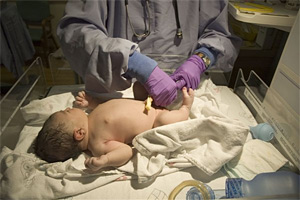 |
 |
 |
 Health & Beauty | June 2006 Health & Beauty | June 2006  
Delayed Umbilical Cord Clamping Can Prevent Anemia
 ucdavis.edu ucdavis.edu


| | Just a two-minute delay in clamping a baby's umbilical cord can boost the child's iron reserves and prevent anemia for months. |
Just a two-minute delay in clamping a baby's umbilical cord can boost the child's iron reserves and prevent anemia for months, report nutritionists at the University of California, Davis.

Iron deficiency is a concern for both wealthy and poor nations. It is a problem particularly in developing countries, where half of all children become anemic during their first year, putting them at risk of serious developmental problems that may not be reversible, even with iron treatments.

Results of the study, conducted by UC Davis nutrition professor Kathryn Dewey and nutrition graduate student Camila Chaparro at a large obstetrical hospital in Mexico City, will be published in the British medical journal The Lancet.

"By simply delaying cord clamping for this brief time, we can provide the infant with the extra blood, and the iron it contains, from the placenta," said Dewey, an expert in maternal and infant nutrition. "This is an efficient, low-cost way to intervene at birth without harm to the infant or the mother."

She noted that although iron deficiency is a greater problem in developing countries, it is also a serious issue in industrialized nations like the United States, particularly for low-income and minority families and in lower birth-weight infants or babies born to iron-deficient mothers.

The umbilical-cord clamping procedure halts blood flow from the placenta to the infant in preparation for cutting the umbilical cord. During the past century, it became common practice to clamp the cord about 10 seconds after the baby's shoulders are delivered. However, there has been little scientific research to justify such rapid clamping.

The previous studies conducted on delaying clamping have indicated no risk and some significant benefits to later clamping.

In the UC Davis study, the researchers set out to specifically evaluate whether delayed clamping improves iron status of full-term, normal-birth-weight infants during their first six months. The researchers also examined whether delayed clamping has greater impact among children who are already at increased risk of developing iron deficiency due to low birth weight or an iron-deficient mother.

The 16-month-long study was conducted at Hospital de Gineco Obstetrica in Mexico City, in collaboration with Mexico's National Institute of Public Health. A total of 476 normal-weight, full-term infants and their mothers were involved in the study. Each mother-child pair was randomly assigned to have the umbilical cord clamped at either 10 seconds or two minutes after the baby's shoulders were delivered.

Data on the infants' diet, growth and illnesses were collected when the children were 2, 4 and 6 months old. Iron status of the babies also was measured at birth and at the end of the study.

Of the original group, 358 mother-child pairs completed the study.

The study revealed that a two-minute delay in cord clamping at birth significantly increased the child's iron status at 6 months of age, and it documented for the first time that the beneficial effects of delayed cord clamping last beyond the age of 3 months.

This also was the first study to show that the impact of delayed clamping is enhanced in infants that have low birth weights, are born to iron-deficient mothers, or do not receive baby formula or iron-fortified milk.

"The data show that the two-minute delay in cord clamping increased the child's iron reserve by 27-47 mg of iron, which is equivalent to one to two months of infant iron requirements," Dewey said. "This could help to prevent iron deficiency from developing before 6 months of age, when iron-fortified foods could be introduced."

Dewey and Chaparro are planning their next stage of research: developing practical guidelines for incorporating the delayed clamping of the umbilical cord into standard obstetric practice in various settings.

http://www.ucdavis.edu | 
 | |
 |



